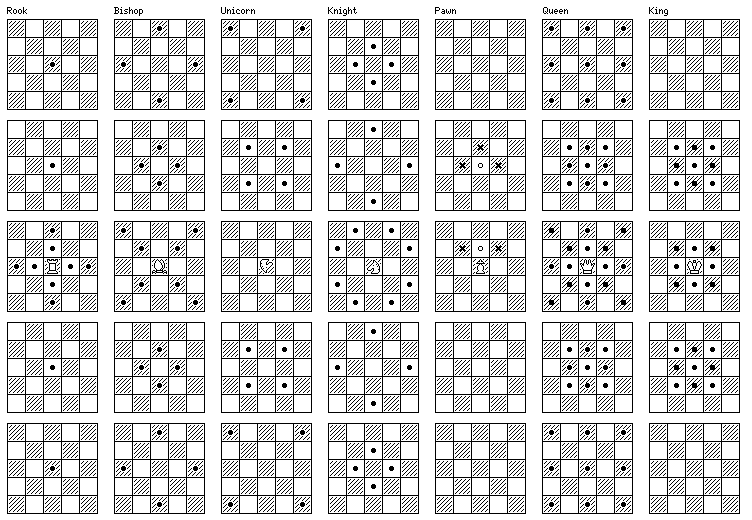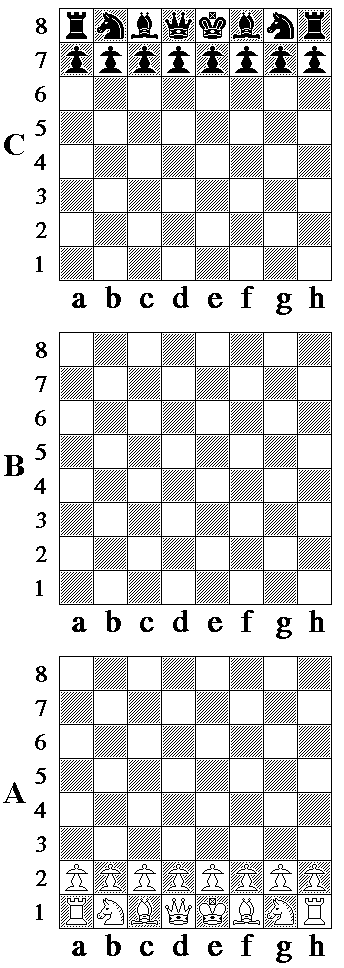
In 1851, the first proposal for a form of three-dimensional Chess was made, called Kubikschach (cubic chess), by Lionel Kieseritsky, better known for having been the loser of the Immortal Game.
This form of the game generalized Chess in what was perhaps the most obvious way, by stacking eight 8 by 8 boards vertically. However, this was considered excessive and impractical, and thus did not achieve enduring popularity.

I first learned about Raumschach (space chess) from Anthony S. M. Dickins' book A Guide to Fairy Chess, in which it was referred to as the Normal Form of Three-Dimensional Chess.
This form of the game was invented by Ferdinand Maack in 1907, and had all the necessary basic elements of a three-dimensional chess variant. It reduced the number of squares to something small enough to be practical, and yet provided enough room so that the pieces could make use of their possibilities of movement.
The initial layout for Raumschach is as shown in the image on the right.
As I have only the flat screen on your computer on which to represent a three-dimensional board, the diagrams of the boards for each level are oriented in the conventional way, with the top of the board representing the more distant side of the board, Black's side, while the diagrams for the boards on the different levels are also stacked in the vertical direction as well.
One new piece, the Unicorn, is included, represented by an upside-down Knight. This piece is the three-dimensional successor to the Bishop; a Rook moves in lines where one co-ordinate is varied, a Bishop moves in lines where two co-ordinates change together, and a Unicorn moves in lines where three co-ordinates change together.
Below is shown a diagram illustrating the moves for each of the pieces in this game. Under the name of each piece - the moves of the Rook, Bishop, Unicorn, Knight, Pawn, Queen, and King being shown in order - is a diagram of the board, in the same arrangement as the diagram to the right of the initial array, showing the available moves for a piece of that type starting from the central square of the board.

One fact that may need to be considered is that the new pieces that are proposed as part of Fairy Chess are generally meant for inclusion in chess problems, rather than as part of a playable chess variant. While Raumschach is a chess variant, and the fact that I first heard of it from a book about Fairy Chess need not say anything about the intentions of its inventor, it still suggests a possible issue.
In the Hexagonal Chess variant invented by Władysław Gliński, the King's diagonal single-step move lets it cross Rook lines, unlike the diagonal move of the King in conventional chess. This might make checkmating the King more difficult; this issue appears to have been addressed in that game by splitting the points 3/4 to 1/4 in the event of a stalemate, so that a stalemate, instead of being a draw, is half a win.
In three-dimensional chess, it seems likely that under many circumstances, inflicting stalemate or checkmate would be almost impossible; given the great additional freedom of movement of all the pieces, blocking every single route of escape for the King would require very large forces.
This is not a problem that is impossible to address; a possible option is a stronger version of something I have already considered as a way to address the issue of "too many draws" in regular Chess. Simply allow Bare King or Perpetual Check as alternative ways to win in three-dimensional chess.
Because the problem is even more serious in three-dimensional Chess, though, perhaps even more radical measures may be needed. One possibility would be to make it possible to win the game by capturing either the King or the Queen, with the exception that the game continues, instead of being won, after one side's Queen is captured if that side can then capture the other side's Queen on the next move.
The idea being that, no matter how impossible it may be to checkmate the King if the possibilities of movement are increased as they are in three-dimensiional Chess, it will always be possible to fork the King and Queen, and so the problem can be solved by replacing an impossible condition for victory with a possible one.

On the left is shown the initial array for Strato Chess, a form of 3D chess invented by John N. Hansen that was commercially available in department stores in the 1970s. At least, that is what I remembered, but apparently the John N. Hansen company is still manufacturing many kinds of games, such as being one of the many manufacturers now making cribbage boards in the "29" design, and they are also still making and selling boards for Strato Chess as well.
I have, however, been able to verify that it was commercially available as far back as the year 1975; an advertisement for it appeared in the New York Times, and it is mentioned in the original edition of A Player's Guide to Table Games by John Jackson as well.
However, looking at the 1975 Sears catalog, they were selling a different 3 by 8 by 8 three-dimensional chess set, described as "Deco-sculpture 3-dimensional chess"; while the specific design of the Strato Chess board was patented, making a three-dimensional chess board by stacking three ordinary chess boards vertically was not protected by any patent.
The rules that came with those sets, however, have been criticized as being ambiguous. More recently, in 2001, William L. d'Agostino invented the game of Millenium 3D Chess, which is played on the same board, with the same initial array, but with different rules.
Personally, I am indeed in agreement that Kieseritzky's original idea of stacking eight boards vertically is impractical.
While Raumschach has all the essential elements of a three-dimensional chess game, even five boards vertically is somewhat awkward, and the fact that the boards are an odd number of squares wide creates a difference from regular chess that is not needed.
On the other hand, having only three boards stacked vertically, while it may allow a game to qualify, just barely, as three-dimensional, is not really enough to let the pieces realize the possibilities of three-dimensional movement.
Therefore, I would be inclined to advocate a three-dimensional chess set that is a stack of four chessboards, each one having 6 by 6 squares. That keeps the number of boards vertically low, but is at least a bit less restrictive than only having three levels. Having 6 by 6 boards avoids making the board too large while still taking advantage of the fact that it's easier to make the board larger in the plane rather than vertically.
One other thing to note, with respect to Raumschach, is that two Unicorns for each side are not really enough; each Unicorn can only reach one quarter of the squares on the three-dimensional chessboard.
Having twelve pawns and twelve pieces on each side, instead of ten pawns and ten pieces, allows the two extra Unicorns to be added. However, there are another two pieces I would like to add.
The Knight is a two-dimensional piece; a three-dimensional knight, that moves by displacing itself one unit in one coordinate, and two units in each of two other coordinates, so as to change color with every move, would be another piece that it would be nice to have in a three-dimensional chess game. (I would be inclined to call that piece a Unicorn, to associate it with the Knight, while giving the Unicorn some other name associated with flight.)